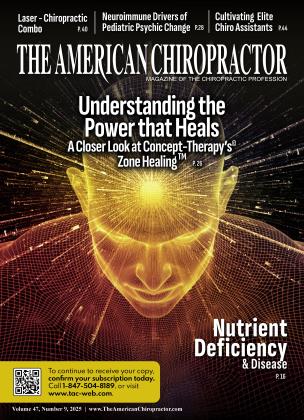Third in a Series of Shields: Identifying High-Risk Patients
September 1 2025 KSJ MurkowskiThird in a Series of Shields: Identifying High-Risk Patients
September 1 2025 KSJ MurkowskiWITH A PERSONAL HISTORY of playing football and sports, I learned a long time ago that the best offense is a strong defense. Today, DCs and CAs in practice must always have a strong “defensive” plan (office manual, staff training) in place with the defensive action protocols of “great documentation” (chart-SOAP notes, staff notes, etc.).
Remember, if it isn’t written, it didn’t happen. No documentation means no defense.
Knowing the 12 types of patients is important.
1. General health (insurance or cash)
2. Auto accident patient
3. Personal injury patient
4. Workers’ compensation patient
5. Medicare patient
6. Medicaid patient
7. General assistance patient
8. County aid patient
9. HMO patient
10. PPA patient
11. PPO patient
12. The one that will sue you (all of the above)
Always have a copy of your state laws and check federal laws.
Remember, do not forget your records release and get a list of all medications, adverse reactions, and prescriber names.
Shields for a good defense:
• A good CA is your first and best line of defense.
• Record good documentation in the doctor-patient interview.
• Take an accurate, comprehensive case history with a review of systems (ROS).
• Examine the area of pain and possible referred pain issues.
Many offices today record (video) the patient intake process. If you choose to do that, make sure to follow HIPAA rules and get patient signatures and releases for all recordings.
Follow the previously mentioned standaid protocols before progressing with a diagnosis, report of findings (ROF), treatment plan, and reviewing alternative care available. Most importantly, always get informed consent — oral-written and documented.
“Many offices today record (video) the patient intake process.”
Remember, judges, jurors, and attorneys expect DCs to follow standards of care and protocol, which means informed consent is done after a patient’s workup, diagnosis, etc.
These are some defensive MAPS to consider that will make your practice happier, safer, and more efficient so you and your staff can concentrate on delivering the highest quality chiropractic care and rehab in your community while addressing the VSC and its eight physical and eight chemical components. See you soon at an MPC CE Seminar.
Screening High-Risk Patients Defense (identify) vs. Offense (care cautions)
Offense: Business Warning Signs
1. Ages 25-55 (most lawsuits filed).
2. Provide only a P.O. Box for an address.
3. Have an unlisted phone number.
4. Come in on the DC’s day off or without an appointment.
5. Patient wants no exam.
6. Patient wants no X-Rays.
7. Patient wants no labs.
8. Patient wants no schedule (oneand-done visit).
9. Patient wants no rehab.
10. Patient has no money or insurance (wants a deal).
11. Patient has a low tolerance for pain.
12. Lists four or more doctors for the same complaint.
Defense: Clinical Warning Signs
1. Failed C-surgery
2. Failed L-surgery
3. Prostatic implants
4. Osteoporosis
5. Osteopenia
6. Hemivertebra
7. Butterfly vertebra
8. Congenital defects
9. Calcified abdominal aorta
10. Scar tissue from surgeries
11. Mental disorders
12. Multiple medications
* These are opinions and suggestions. This is not to be considered as legal advice.

Dr. KSJ Murkowski, D.C., is an internationally recognized chiropractic leader, educator, and motivational speaker. He serves as President of Master Practice Counselors and has earned numerous honors, including Michigan Doctor of the Year (twice) and multiple meritorious awards. A former state president and board chairman, he has testified before the U.S. Senate, contributed to ICD-10 coding for the WHO, and serves as an expert witness across North America. He is also a proud father of three accomplished chiropractic doctors. If you have any questions call 517-7849123 or email [email protected].
 View Full Issue
View Full Issue






